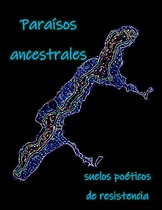Paraísos ancestrales, suelos poéticos de resistencia.
Citación
Fecha
2020Autor
Sotelo Cuevas, Luz Maryule
Triana Montes, Liz Juvelly
Director / Asesor / Tutor
Gutiérrez Vásquez, Martín Kanek
Palabras claves
Humedal
Tibabuyes
Pensamiento ancestral
Acto poético
Pedagogía reflexiva
Arte de la tierra
Caño
Pagamento
Ofrenda
Resistencia
Bitácora
Plataformas virtuales
Deidad
Comunidad
Canción
Escultura
Comunicación cósmica
Keyword
WetlandTibabuyes
Ancestral thinking
Poetic act
Reflective pedagogy
Earth art
Spout
Payment
Offering
Endurance
Binnacle
Virtual platforms
Deity
Community
Song
Sculpture
Cosmic communication
Metadatos
Mostrar el registro completo del ítemResumen
Trabajo de grado que propone inferir las características sensibilizadoras que posee el Arte de la Tierra, como una práctica que ha posibilitado una serie de ejercicio significativos desde las necesidades y problemáticas del Humedal Tibabuyes, tales como: la urbanización y construcción de canchas sintéticas sobre este territorio por parte de la alcaldía de Enrique Peñaloza; afectando el ecosistema y destruyendo la carga ancestral que está poseía, dado que, las comunidades Muiscas han sido desplazadas por la urbanización y menospreciadas por algunos ciudadanos que le llaman “caño” a este territorio sagrado para estos pueblos originarios. De manera que, hemos desarrollado una serie de laboratorios de creación, a partir de la siembra de Paraísos Ancestrales (resignificación de las huertas) junto a las comunidades. En primer lugar, la comunidad virtual se convocó por redes sociales debido a la contingencia del Covid-19 con ellos se desarrollaron laboratorios por medio de nuestro canal de YouTube para la creación de bitácoras a partir del contenido audiovisual subido a la plataforma, como: animaciones de la cultura muisca, video-tutoriales para sembrar huertas caseras y nuestra canción-ritual “No me digas caño… Tibabuyes soy”. Por otra parte, la comunidad presencial, la cual es un grupo de personas que siembra huerta directamente en el Humedal, construyó junto a nosotras algunos actos de resistencia mediante la creación de deidades en arcilla, un cadáver exquisito y entonamos nuestra canción-ritual junto a un compartir de alimentos. Por consiguiente, tomamos nuestro proyecto como un acto poético de agradecimiento y pagamento que devolverá a Tibabuyes las bondades que nos ha brindado.
Abstract
Degree work that proposes to infer the sensitizing characteristics of the Art of the Earth, as a practice that has made possible a series of significant exercise from the needs and problems of the Tibabuyes Wetland, such as: the urbanization and construction of synthetic courts on this territory by the mayor of Enrique Peñaloza; affecting the ecosystem and destroying the ancestral burden that it possessed, since the Muiscas communities have been displaced by urbanization and despised by some citizens that they call "caño" to this sacred territory for these native peoples. So, we have developed a series of creation laboratories, from the sowing of Ancestral Paradises (resignification of the orchards) together with the communities. In the first place, the virtual community was convened through social networks due to the Covid-19 contingency, with them, laboratories were developed through our YouTube channel for the creation of blogs from the audiovisual content uploaded to the platform, such as: animations of the Muisca culture, video-tutorials to plant home gardens and our song-ritual “No me digas caño... Tibabuyes soy”. On the other hand, presencial community, which is a group of people who plant gardens directly in the Wetland, built together with us some acts of resistance by creating deities in clay, an exquisite corpse and we sang our song-ritual together with a sharing of food. Therefore, we take our project as a poetic act of gratitude and payment that will return to Tibabuyes the kindness that he has given us.
Editorial
Universidad Pedagógica Nacional
Programa académico
Licenciatura en Artes Visuales

